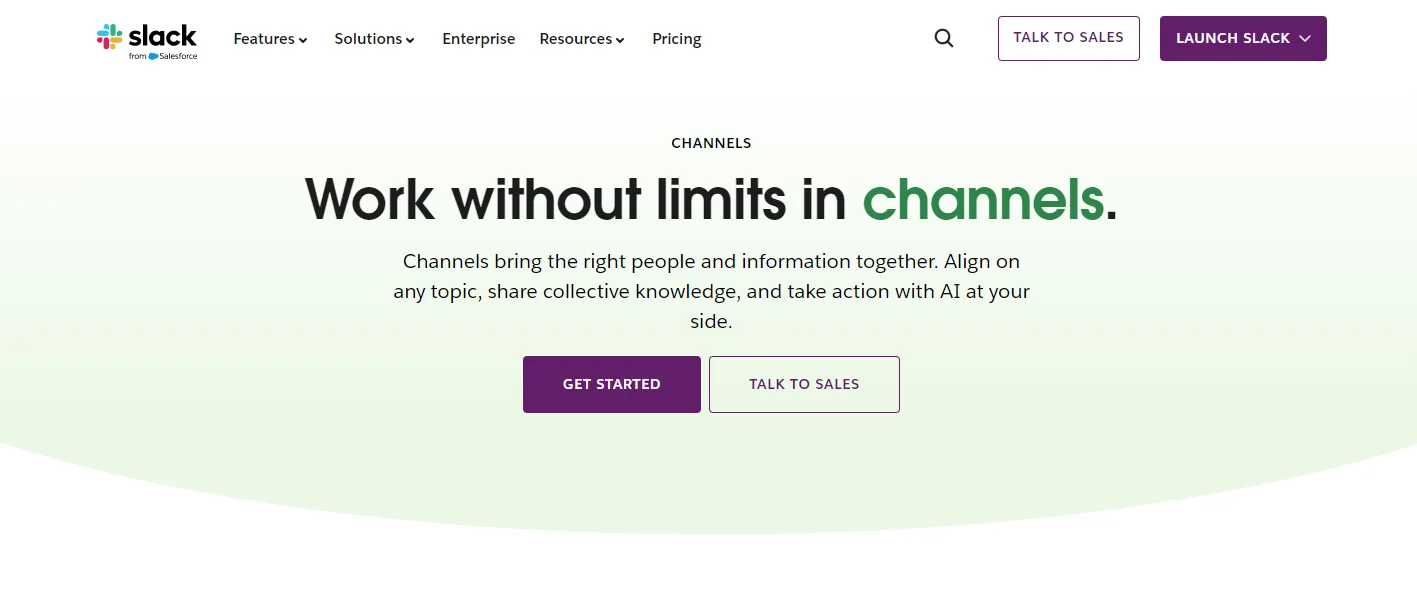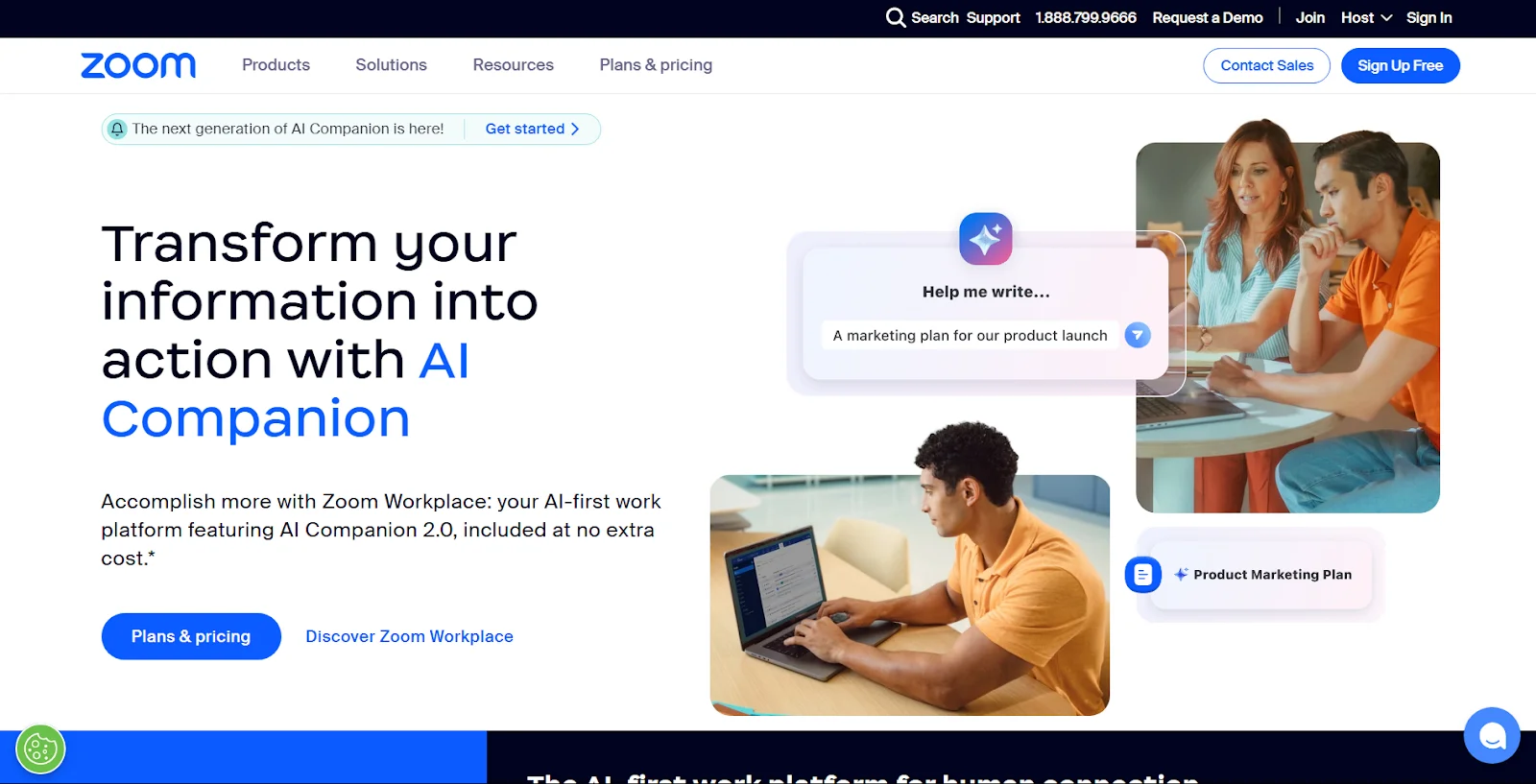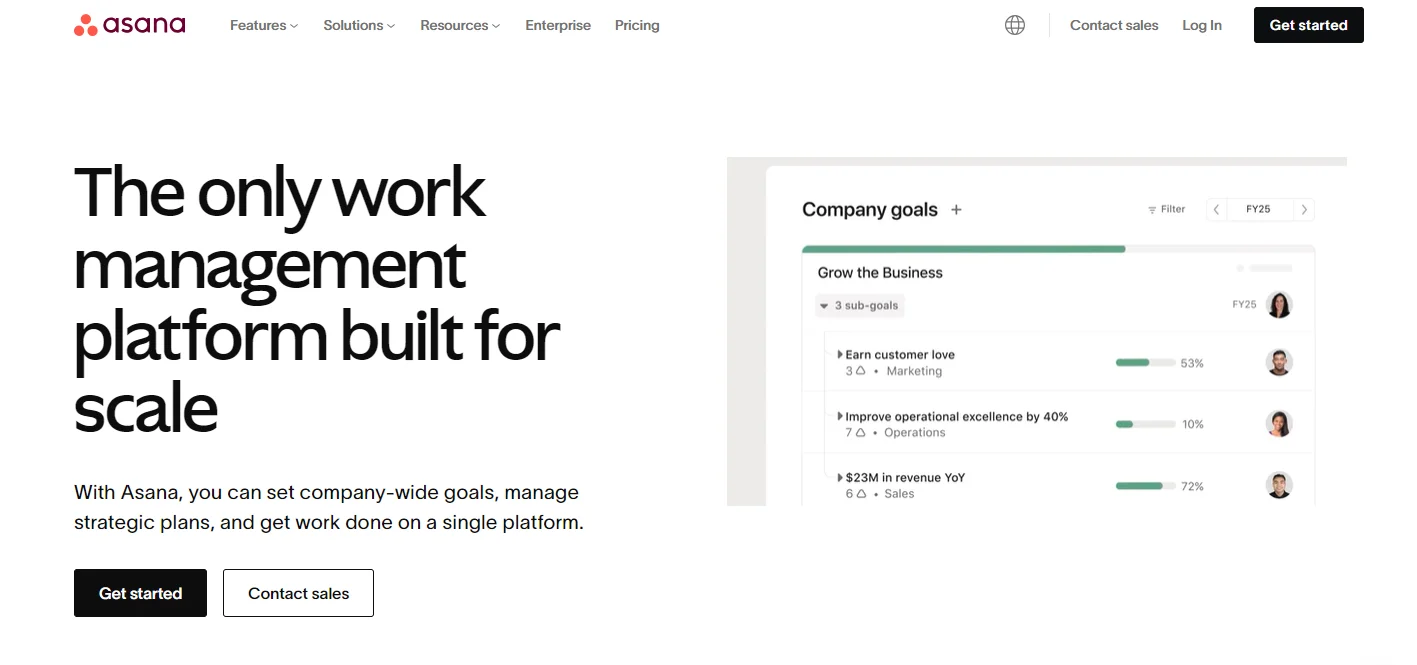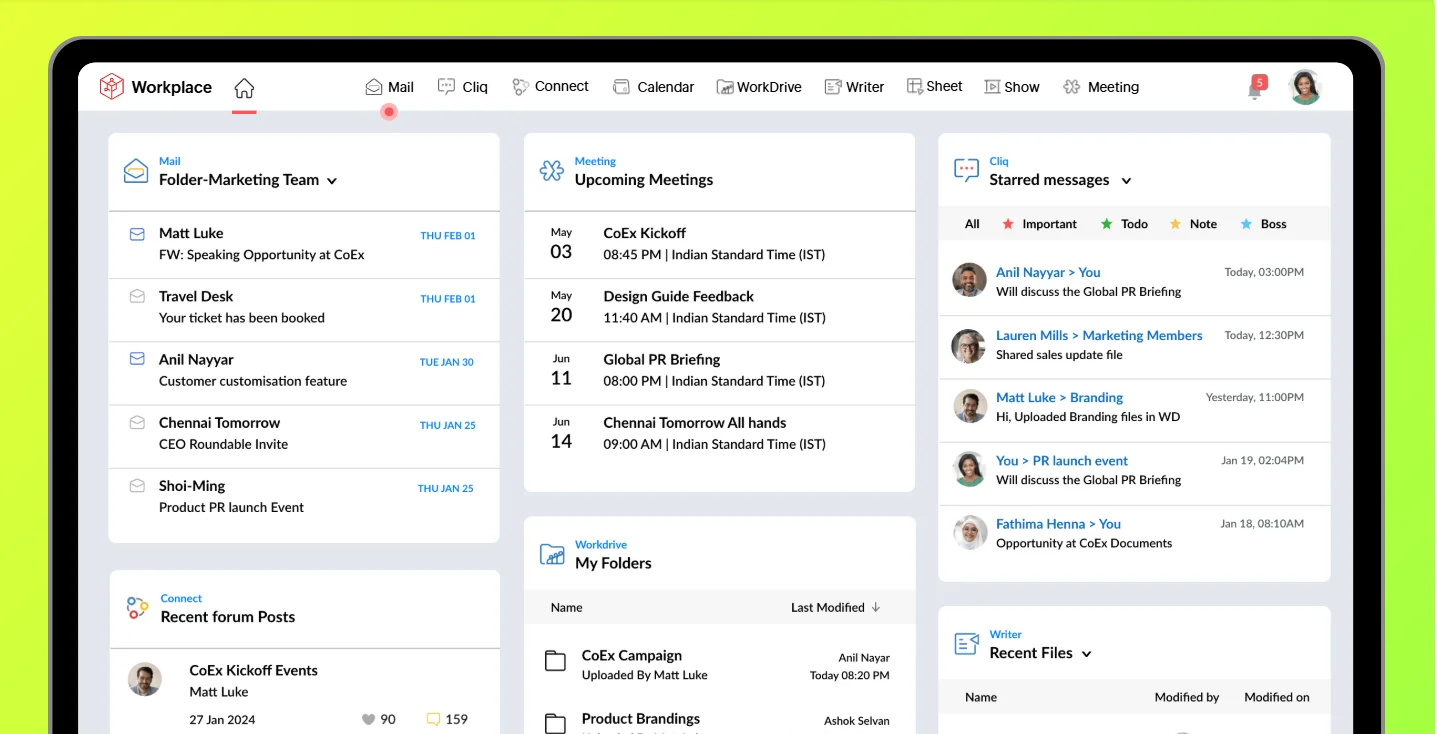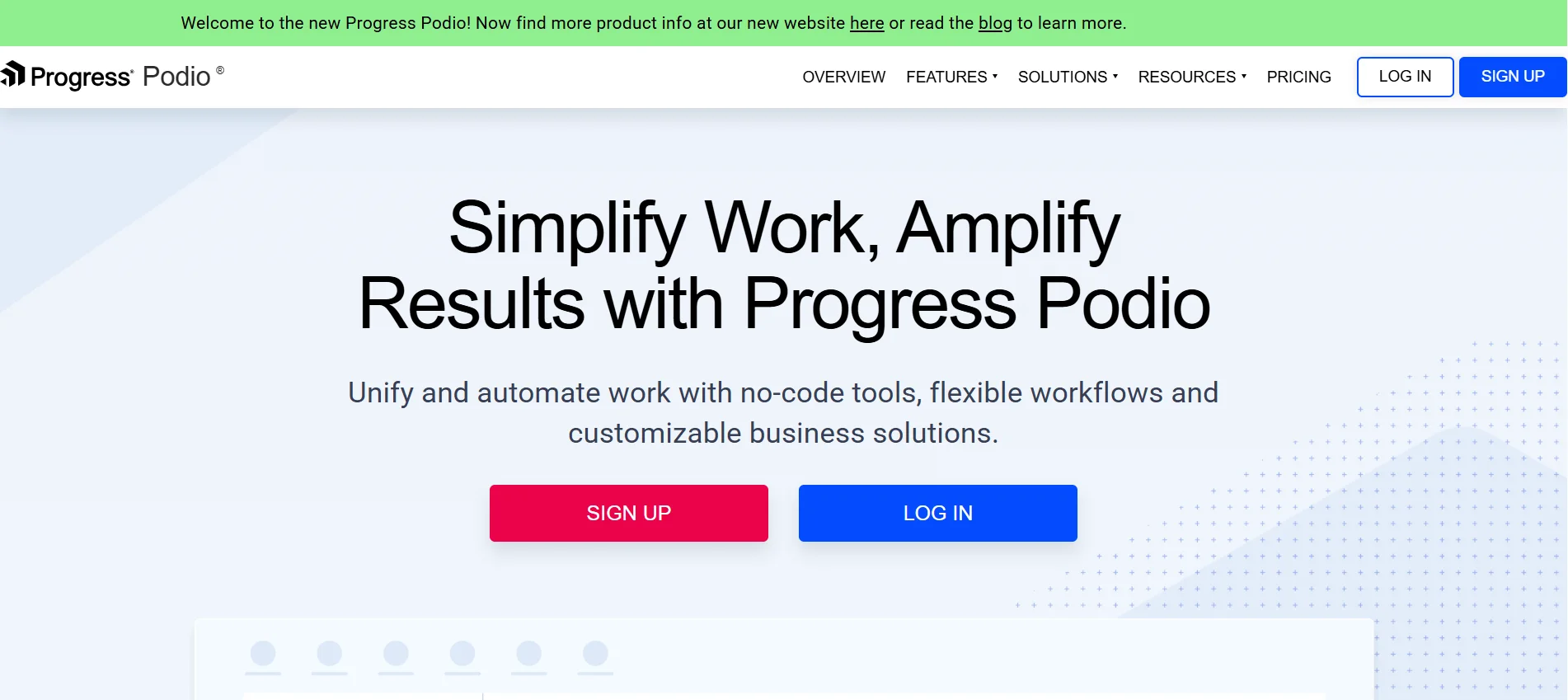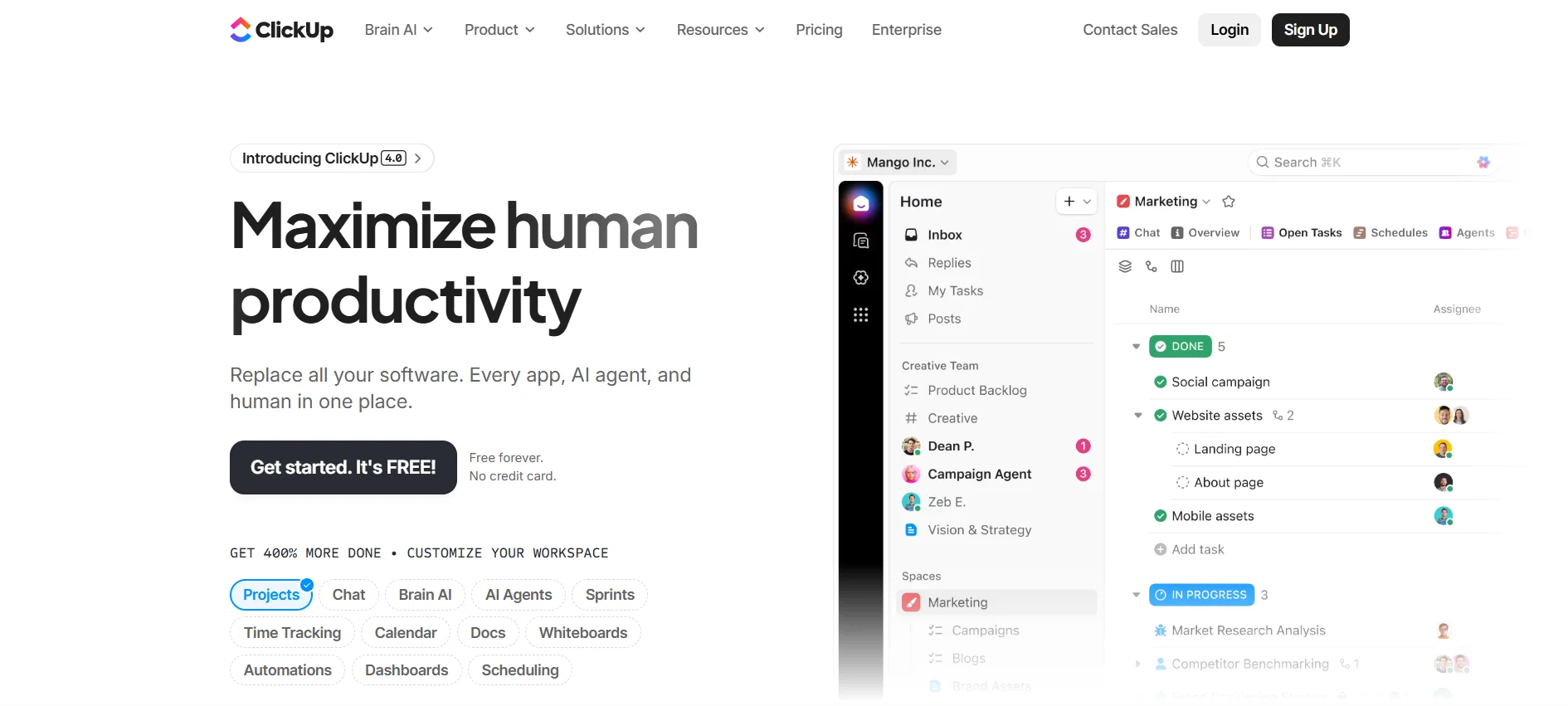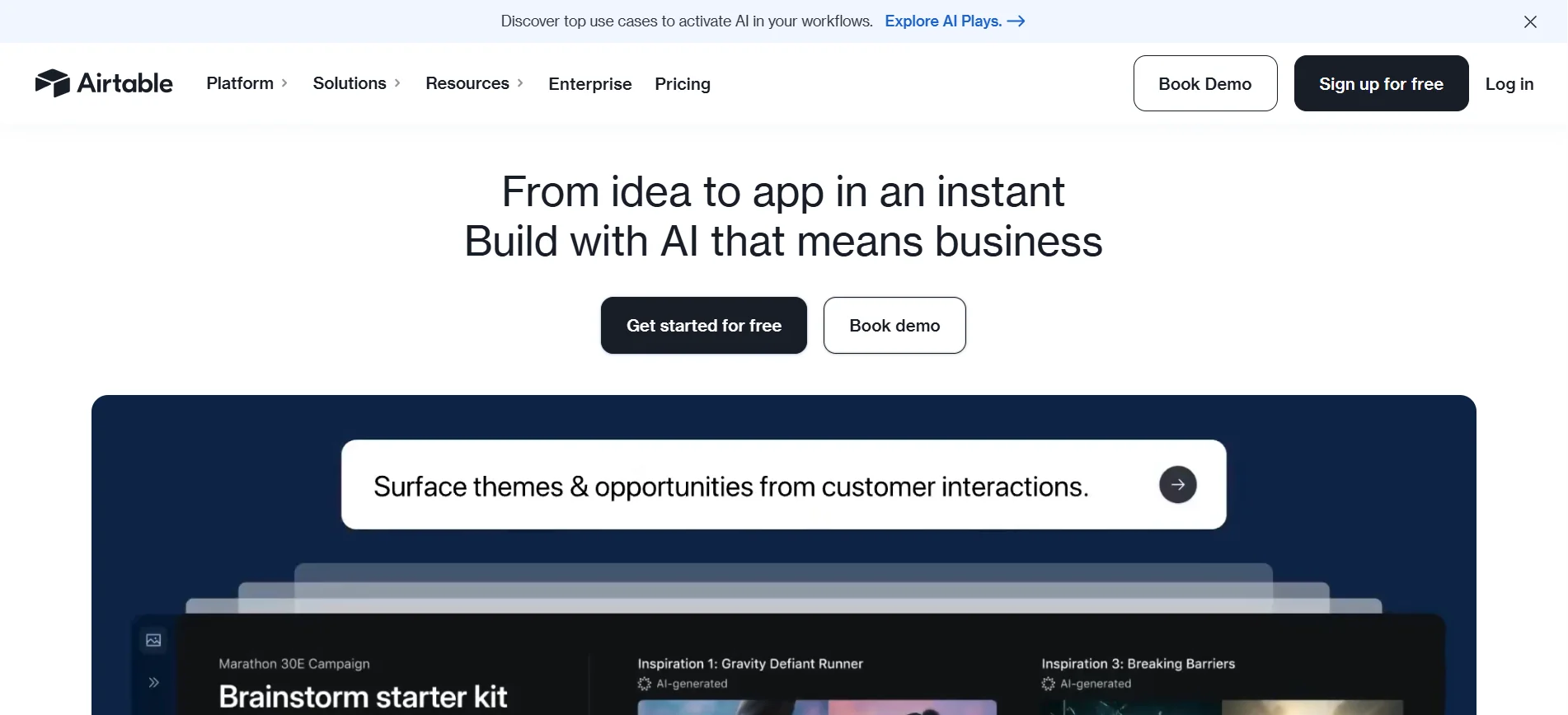Blog
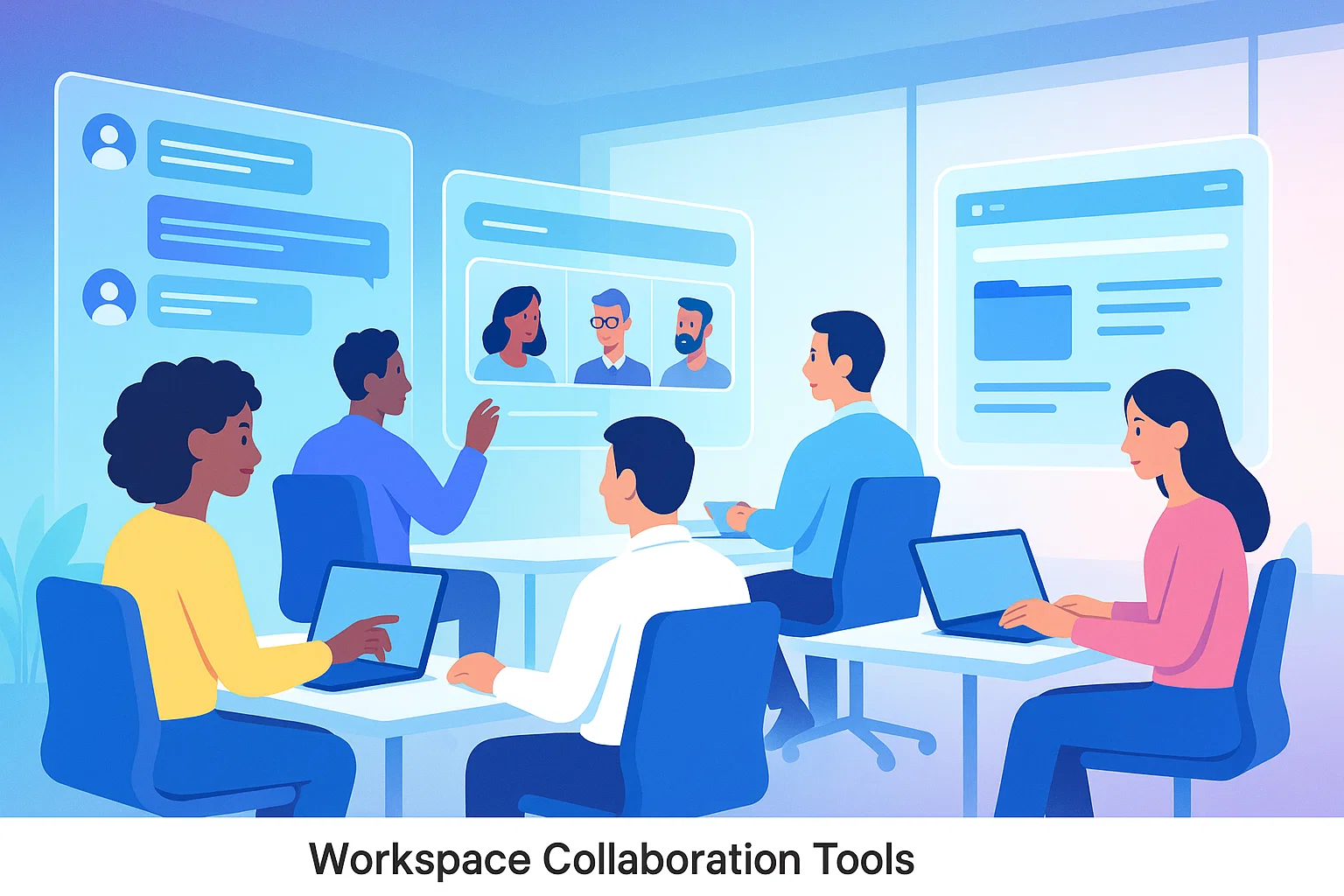
Top 9 Workspace Collaboration Tools in 2026: Boost Team Productivity
In today’s evolving work environment, collaboration is essential for teams to communicate, share ideas, and achieve goals efficiently.
Remote and hybrid work models make it even more important for teams to have reliable tools to manage projects and track progress seamlessly.
Workspace collaboration software not only streamlines daily workflows but also helps reduce misunderstandings, improve productivity, and meet deadlines consistently.
These tools empower teams to organize tasks, centralize communication, and share documents in real time, ensuring everyone stays aligned.
In this guide, we explore the top 9 collaboration tools for 2026, providing a detailed comparison and practical insights for each platform.
A Quick Comparison Table of Top Workspace Collaboration Tools
| Tool | Best For | Key Features | Pricing (Basic Overview) |
|---|---|---|---|
| Slack | Team communication | Channels, messaging, integrations, threads, file sharing | Free + Paid tiers |
| Zoom | Video conferencing | Meetings, webinars, screen sharing, AI summaries | Free + Paid |
| Asana | Project management | Tasks, timelines, automation, reporting | Free + Paid |
| Trello | Visual project boards | Kanban boards, templates, drag & drop | Free + Paid |
| Zoho Workplace | All-in-one office suite | Email, chat, docs, drive, collaboration | Paid |
| Podio | Custom workflows | CRM, apps, task management, automation | Free + Paid |
| monday.com | Work OS | Project dashboards, automations, reporting | Paid |
| ClickUp | Unified productivity | Tasks, docs, goals, whiteboards, automations | Free + Paid |
| Airtable | Database workflows | Tables, calendars, Kanban, automations | Free + Paid |
Top Workspace Collaboration Tools for 2026
Slack is a powerful team communication platform that helps organizations keep conversations organized and easy to follow. It replaces long email threads with real-time messaging, channels, and searchable discussions. Teams can collaborate through text, audio, and quick video clips while staying aligned on tasks and updates. Slack also supports hundreds of integrations, allowing you to manage work without switching between multiple tools. Whether your team is remote or office-based, Slack keeps everyone connected and productive.
1. Slack: Best for Team Communication
Slack is a powerful team communication platform that helps organizations keep conversations organized and easy to follow. It replaces long email threads with real-time messaging, channels, and searchable discussions. Teams can collaborate through text, audio, and quick video clips while staying aligned on tasks and updates. Slack also supports hundreds of integrations, allowing you to manage work without switching between multiple tools. Whether your team is remote or office-based, Slack keeps everyone connected and productive.
Key Features
- Workflow builder: Create automated workflows using a simple drag and drop builder. You can collect information, automate notifications, forward tasks, request approvals, and organize processes without writing code.
- Huddles for instant meetings: Start audio or video huddles with one click. Participants can chat, share screens, transfer files, and collaborate in real time without leaving the channel.
- External collaboration: Invite clients, agencies, and vendors to shared channels even if they do not use Slack. This keeps all communication organized in a single space.
- Deep integrations: Connect tools like Google Workspace, Trello, Asana, Notion, and Zoom to bring all your digital work into one platform.
Pricing: Slack offers three paid plans from 7.25 to 12.50 dollars per user each month, plus a free version that supports unlimited channels.
Best For: Teams that want fast, centralized communication without relying on long email threads.
2. Zoom: Best for Video Collaboration
Zoom is a leading video communication platform trusted by companies of all sizes. It offers smooth, high-quality video calls that make virtual collaboration feel more natural and engaging. Teams can host meetings, webinars, and training sessions with ease, using tools like screen sharing, breakout rooms, and AI-powered meeting summaries. Whether you’re connecting with clients or running internal meetings, Zoom ensures every interaction is professional and productive.
Key Features
- HD video and audio meetings: Host reliable virtual meetings with large groups and access tools like waiting rooms and in meeting chat.
- Breakout rooms: Divide participants into smaller rooms for group discussions or training activities.
- Screen sharing and whiteboard: Share your screen or use an interactive whiteboard to brainstorm ideas together.
- Recording and transcripts: Automatically capture meeting recordings and generate transcripts for easy reference.
- Calendar integration: Connect with Google Calendar or Outlook to schedule and join meetings quickly.
Pricing: Zoom Workplace has a free version and two paid plans from $13.33 to $18.33 monthly, per user.
Best For: Distributed teams, client facing businesses, educators, and organizations that depend on high quality video communication.
3. Asana: Best for Project Management
Asana is a structured project management tool designed to bring clarity to every workflow. It helps teams track tasks, manage deadlines, and visualize project progress through timelines and boards. Managers can assign responsibilities, monitor workloads, and automate repetitive processes to keep teams focused on meaningful work. Asana makes complex projects easier to manage by centralizing communication, files, and updates in one place.
Key Features
- Task assignment and scheduling: Assign tasks with due dates, priorities, subtasks, and descriptions so everyone stays clear on what to do next.
- Timelines and milestones: Visualize projects with Gantt style timelines to track dependencies and major goals.
- Workflow automation: Use rules and templates to automate repetitive actions such as assigning tasks or moving items between stages.
- Reporting dashboards: View project performance, workload insights, and team progress in real time.
- Integrations: Connect with Slack, Microsoft Teams, Google Workspace, Zoom, Dropbox, and more.
Pricing: Asana offers a free version and two paid plans that range from $10.99 to $24.99 monthly per user.
Best For: Teams managing complex projects with multiple contributors or departments.
4. Trello: Best for Visual Task Management
Trello offers a simple, visual approach to managing work through drag-and-drop Kanban boards. It’s ideal for teams that prefer an easy-to-understand layout where tasks move across stages. Trello uses cards, lists, and labels to help teams track progress, share updates, and collaborate in real time. It’s beginner-friendly, highly customizable, and equipped with Power-Ups that expand functionality when needed.
Key Features
- Kanban boards: Organize tasks into cards and lists that represent different project stages.
- Custom templates: Use prebuilt templates for marketing, operations, product design, and personal planning.
- Task elements: Add labels, checklists, due dates, and attachments to keep task details organized.
- Power Ups: Integrate apps like Google Drive, Slack, Notion, and Jira to enhance your workflows.
- Real time collaboration: Multiple users can update boards at the same time without conflicts.
Pricing: Trello has four plans ranging from free to $17.50 monthly per user.
Best For: Small teams, marketing groups, creative departments, and simple task management needs.
5. Zoho Workplace: Best for All in One Productivity
Zoho Workplace provides a complete suite of productivity tools in one unified platform. It combines email, file storage, document editing, team chat, and video meetings into a seamless workspace. The platform is ideal for businesses that want to reduce tool switching and manage their operations under a single ecosystem. Zoho’s cost-effective plans and deep integration with other Zoho apps make it a practical choice for growing companies.
Key Features
- Zoho Mail: Host professional email accounts with advanced security and spam protection.
- Document collaboration: Work together on documents, spreadsheets, and presentations through Zoho Writer, Sheet, and Show.
- Communication tools: Use built in chat and video conferencing to stay connected with your team.
- Cloud storage: Store and manage files securely with role based permissions.
- Wide integrations: Connect with other Zoho apps like CRM plus external apps through APIs.
Pricing: Zoho Workplace has 4 plan options that range from $1 to $6 monthly per user.
Best For: Small and medium sized businesses that want an affordable collaboration and productivity suite.
6. Podio: Best for Custom Workflows
Podio is a highly customizable collaboration tool that adapts to nearly any workflow. Instead of forcing teams into rigid structures, it allows users to design apps, dashboards, and workspaces tailored to their needs. Whether you’re managing CRM processes, project tasks, or internal data flows, Podio helps teams build the exact system they want. It’s flexible, powerful, and ideal for organizations looking to streamline operations through personalization.
Key Features
- Custom apps: Build personalized apps for CRM, project tracking, onboarding, content calendars, and more.
- Task management: Create tasks with priorities, deadlines, categories, and comments.
- Collaboration tools: Use messaging, file sharing, and team updates in one platform.
- Workflow automation: Automate repetitive tasks and notifications through integrated tools.
- Analytics and reporting: Track performance through detailed, customizable dashboards.
Pricing: Podio has 3 plans that range from free to $19.20 monthly per user.
Best For: Teams that need customizable workflows for CRM, operations, real estate, or project management.
7. monday.com: Best for Scalable Work Management
monday.com is a visual Work OS that helps teams plan, track, and automate work across departments. Its colorful boards, charts, and dashboards make complex data easy to understand at a glance. The platform scales effortlessly, supporting everything from small projects to enterprise operations. With automations, app integrations, and flexible views, monday.com creates a structured environment where teams can collaborate without confusion.
Key Features
- Visual boards: Manage everything from marketing campaigns to HR workflows using intuitive and customizable layouts.
- Automations: Save time by automating routine actions like status updates, notifications, and assignments.
- Multiple views: Switch between timeline, calendar, workload, Kanban, and table views.
- Third party integrations: Connect with Slack, Zoom, Excel, Google Workspace, Canva, and hundreds of other tools.
- Reporting: Use analytics to review performance and project progress.
Pricing: Monday has 4 plans ranging from $9 to $19 monthly per user.
Best For: Medium to large organizations that need a scalable platform across multiple departments.
8. ClickUp: Best All in One Productivity Platform
ClickUp unifies tasks, documents, chat, goals, and whiteboards into a single productivity hub. Its goal is to replace multiple tools like Notion, Asana, and Slack by offering everything in one platform. Teams can manage standard workflows, store knowledge, and collaborate on documents without relying on additional tools. ClickUp’s flexibility makes it suitable for almost any team because it adapts to different work styles and industries.
Key Features
- Advanced task management: Create tasks with dependencies, priorities, subtasks, and custom fields.
- Docs and wikis: Build internal knowledge bases and project documentation inside ClickUp.
- Goal tracking: Monitor OKRs and team objectives with real time progress and milestones.
- Whiteboards: Collaborate visually with mind maps and idea boards.
- Integrations and automation: Connect to hundreds of tools and automate routine processes.
Pricing: ClickUp offers four plans ranging from free to $12 monthly per user.
Best For: Productive teams that want one unified hub for tasks, documents, and collaboration.
9. Airtable: Best for Database Driven Collaboration
Airtable blends the simplicity of spreadsheets with the power of relational databases. It allows teams to organize structured data like content calendars, workflows, inventory, or marketing pipelines. Airtable’s views—such as Kanban, Grid, Calendar, and Gallery—make it easy to display information in the format that works best. It’s highly flexible, visually appealing, and ideal for teams that rely on data-rich processes.
Key Features
- Relational databases: Organize data with linked records, structured fields, and flexible tables.
- Multiple views: Switch between grid, Kanban, gallery, and calendar views based on your workflow.
- Automations: Build custom workflows to send alerts, update records, or integrate with other tools.
- Integrations: Connect Airtable to Slack, Gmail, Notion, Zapier, and external apps.
- Real time collaboration: Multiple team members can edit and update databases simultaneously.
Pricing: AirTable has four plans from free to $45 monthly per user.
Best For: Content teams, operations, marketing, and creative projects that require structured data.
How to Choose the Right Workspace Collaboration Tool for Your Team
Selecting the best collaboration platform depends on your team’s workflow, communication style, and the tools you already rely on. Each solution offers unique strengths, so the right choice should align with your goals, team size, and daily operational needs.
Here’s a simple breakdown to help you decide:
- Choose Slack: If your team prefers fast, text-based communication or needs organized channels for projects and departments.
- Choose Zoom: If your company relies heavily on video meetings, webinars, virtual training, or hybrid communication.
- Choose Asana: If you need a reliable and affordable way to manage tasks, deadlines, and shared team projects.
- Choose Trello or monday.com: If visual project boards, drag-and-drop task management, and workflow organization are your top priorities.
- Choose Airtable: If your teams work across multiple platforms and need a powerful way to unify data, projects, and content pipelines in one place.
- Choose Zoho Workplace: If you want an all-in-one productivity suite that combines email, chat, file storage, and document editing.
- Choose Podio: If your workflows are highly customized and require flexible apps, CRM tools, and tailored automations.
Conclusion
Collaboration tools have become essential for modern teams, especially as hybrid and remote work continue to evolve. The right platform can simplify communication, reduce project delays, and create a more connected and productive workplace. Each tool in this list brings unique strengths, whether your team needs better messaging, seamless video meetings, visual task management, or database-driven workflows.
When choosing a collaboration tool, focus on how well it aligns with your team’s work style, project needs, and long-term goals. Test different options, explore their integrations, and evaluate how effectively they improve daily workflows. A well-chosen tool not only boosts performance but also strengthens teamwork and supports a healthier, more efficient work environment.
By investing in the right collaboration platform, your organization can stay agile, deliver faster, and build a workplace where teams can do their best work—no matter where they are.
Frequently Asked Questions (FAQs)
What is a workspace collaboration tool?
A workspace collaboration tool is software that helps teams communicate, manage tasks, share files, and work together in real time across different locations.
How do collaboration tools integrate with other platforms?
Most tools provide APIs and built-in integrations for apps like Google Workspace, Outlook, Slack, Zoom, and project management systems through webhooks or third-party connectors.
Are collaboration tools secure for file sharing and communication?
Yes, leading platforms use encryption, access controls, SSO, and compliance certifications like SOC 2 and ISO 27001 to ensure secure data transfer and storage.
What is the difference between a project management tool and a collaboration tool?
Project management tools track tasks, deadlines, and workflows, while collaboration tools focus on communication. Many modern tools combine both features.
Can these tools support hybrid and remote teams?
Yes, they are designed for distributed teams with features like cloud access, real-time editing, video meetings, and shared workspaces from any device.
How do collaboration tools improve productivity?
They reduce communication delays, centralize information, automate tasks, and provide shared visibility into project progress, improving team efficiency.
Do collaboration tools require high system specifications?
Most run in the cloud and only require a modern browser. Video tools like Zoom may need higher bandwidth and updated hardware for HD calls.
How do real-time collaboration features work?
Real-time updates use WebSockets or similar technology to sync changes instantly across users, ensuring live editing, messaging, and shared dashboards.
Can these tools scale for large organizations?
Yes, tools like Asana, monday.com, and Slack offer enterprise plans with admin controls, role permissions, advanced security, and performance scalability.
How do automation features work in collaboration platforms?
Automation triggers tasks such as reminders, notifications, status updates, and workflow routing using rule-based systems or no-code workflow builders.
Do collaboration tools offer mobile apps?
Most major platforms provide Android and iOS apps with messaging, task management, file access, and notifications optimized for mobile workflows.
How is data stored and backed up in these tools?
Data is stored in secure cloud servers with automatic backups, redundancy, and region-based storage depending on the vendor’s infrastructure.









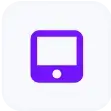

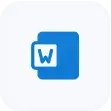



































 Support
Support  Demo
Demo  Blog
Blog 